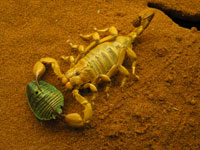Scorpions |
 Instantly recognized by their eight legs, oversized claws, and curved, stinger-armed tails, scorpions are members of the scientific order Scorpiones, itself a part of the class Arachnida. With over 1700 individual species catalogued in the scientific literature, scorpions live in most environments, with the exception of tundras, taigas, and the peaks of snow-covered mountains. Of these species, as many as 25 are known to have venom toxic to humans. Living between 5 and 25 years and growing up to 5 inches in length, scorpions are primarily nocturnal predators, with their main prey being small insects. So as to evade their own predators, such as birds and rats, they prefer to hide in cool, dark areas such as the crevices beneath rocks during the day, though it should be noted that, unlike some animals that remain in near paralysis during their inactive periods, scorpions are quite capable of using their stinger at any time. Though the vast majority of scorpions cannot harm humans with their venom, it is for this reason that someone who is unfamiliar with the different species and subspecies should not handle any individuals they come across. Found throughout the Old World and Americas, with the exceptions to their natural occurrence being Antarctica, New Zealand, and, formerly, Great Britain, scorpions have been known to most civilizations for millennia. They are, in fact, the inspiration for one of the signs of the traditional zodiac. With the development of world shipping and the exotic pet trade, they have also been introduced to formerly alien environments, such as Great Britain and the islands of Oceania. Given that some of the smaller, and occasionally dangerous, species are native to equatorial regions, their presence in crates carrying fruits and vegetables to the developed world has become a growing nuisance. However, scorpion venom has also gained the interest of cancer researchers, who see its ability to bind with glioma cells as something that can be utilized in the detection and treatment of the disease. Beyond their adaptability and fierce reputation, scorpions also possess several interesting quirks and traits. One is their tendency to become fluorescent under ultraviolet lights, such as blacklights. Indeed, a tan or black scorpion can appear to glow with various bright colors under such lighting, even at night, an oddity that is often used to detect these nocturnal predators. Scorpions are also known for having varying numbers of eyes. Species within the same genus can have between two and five pairs of eyes. Finally, some of the scorpion's most unusual aspects are behavioral. When engaging his partner in courtship, the male will often clasp the claws of the female with his own, as if holding hands, and proceed to spin around with her for up to a day. This apparent 'dancing' is intended to keep the female occupied while the male looks for an appropriate location to deposit his spermatophores. The young are born one by one and, unlike with most arachnids, stay with the mother for an extended time. |
FREE QUOTE
Let's Get Started...
Save 20% By Scheduling Online...
Address
 Website Powered by BannerOS. Your Business Energized!
Website Powered by BannerOS. Your Business Energized!





